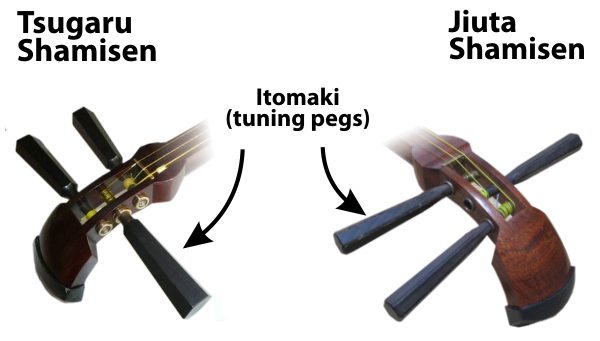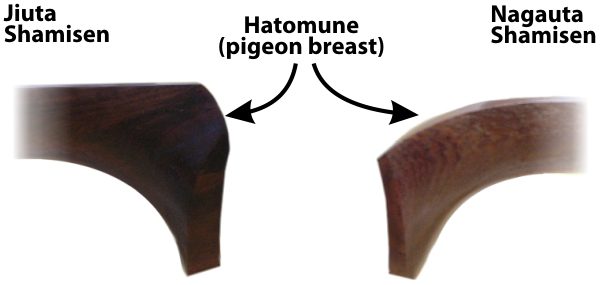First, let’s learn about the three main sizes of shamisen and a few of the many styles associated with them.
Note: The shamisen styles explained below are commonly used with a particular neck size, but please know that the styles don’t necessarily require specific sizes. For example, shamisen for tsugaru style are often futozao size (thick neck), but they are also made as hosozao (thin neck) to accommodate the player’s size. Likewise, shamisen for nagauta style often use hosozao size (thin neck), but they also have been made with surprisingly thick necks as well.
Thus, more importantly than using a specific size, feel free to learn any style you like on any kind of shamisen you can get. If you have a hosozao shamisen want to learn the tsugaru style, feel free to learn that style! After all, even though the modern futozao shamisen is said to have been made for tsugaru players, the bousama of tsugaru (wandering shamisen players) very often played their tsugaru style pieces on hosozao shamisen. Why can’t you? 🙂
Futozao (Thick Neck Size)
Futozao is commonly used for tsugaru style or gidayu style.

The sharp, hard-striking tsugaru style is said to have originated on the streets by the bousama (blind musicians), who developed a livelier style to attract audience. In recent years, many talented musicians have taken up the tsugaru shamisen and has brought it to popularity as a virtuosic instrumental style. The bachi is smaller with much variety in weights/flexibility for the individual’s preferences. The koma has a relatively short height of 8mm. Out of all shamisen styles, you have the greatest chance of getting laid with tsugaru style (and even then, the chances are not great)

This is another style for futozao shamisen. Rather than the solo-centric tsugaru style, the Gidayu style was developed to be played along with plays. This style uses a bachi with 7mm thick tips. For reference, the tips of bachi for tsugaru shamisen are between 1~2mm, so 7mm is seriously thick stuff. The koma is around 19mm tall. The extreme sizes/thicknesses of the accessories lend to the unique tone of gidayu shamisen.
Chuuzao (Medium Neck Size)
Chuzao Shamisen is commonly used for jiuta (traditional classic music) or minyo (Japanese folk songs).

Jiuta means “songs of the country” and, in the Edo period. From the early 18th century, occasions for shamisen to play together with koto became common and now, there is a very close relationship between koto and Jiuta. The Jiuta style is said to be a more refined style. The bachi can be as wide as 14cm, not the easiest accessory to conceal in a purse.
Minyo is connected to forms of work or to specific trades and were originally sung between work or for specific jobs. Other Minyo function simply as entertainment, as dance accompaniment, or as components of religious rituals. Minyo style can be played with any shamisen size.
Hosozao (Thin Neck Size)
Hosozao Shamisen is generally for Nagauta (traditional singing or chanting), Kouta and Hauta (old popular song).

Nagauta means “long song” and began as several short songs strung together. Because it developed the most within the Kabuki theater in Edo, it is often called “Edo Nagauta”. As the chief instrument used in kabuki, it is played in a wide range of modes, including very slow, regular songs, but can also be played quite rapidly, employing a variety of accenting techniques. Nagauta bachi are traditionally made from ivory, but are more commonly made from wood or plastic.
What’s the difference?
The itomaki of a tsugaru shamisen are about 2.5cm at the thickest point, much thicker than the other shamisen. Just by looking at the two shamisen below, you can tell which one is the tsugaru shamisen. (especially since we have them labeled!)

When the skin is glued to the dou (body), extra skin is glued to the sides.
On a tsugaru shamisen, the length of skin stuck to the sides is about 2.5cm long. On the other two shamisen, the extra skin is about 5mm long.

Though it’s easy to differentiate from the tsugaru shamisen by the size of the itomaki, it looks much more similar to the nagauta shamisen, because the itomaki are more similar. This is the best way to find the difference is looking at the base of the sao (neck), called the Hatomune.

Hatomune (slope at the end of neck)
The hatomune of a jiuta shamisen cuts off sharply, whereas the hatomune of a nagauta shamisen slopes downward.
The Gidayu shamisen looks cross-between a nagauta shamisen and a tsugaru shamisen. Like the tsugaru shamisen, there is about 2.5cm of skin attached to the sides of the dou and a thick neck. But like the nagauta shamisen, the neck swoops down, rather than cutting off sharply (which the tsugaru/jiuta shamisen both have)
Sanshin (三線)

The Sanshin is from Okinawa. Though not technically a shamisen, it is sometimes confused as one because Ebay auctions often sell sanshin, labeling them as shamisen.
How to recognize a sanshin
Err… really? 😉
